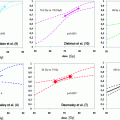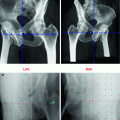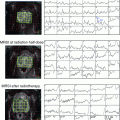© Springer-Verlag Berlin Heidelberg 2014
Hans Geinitz, Mack Roach III and Nicholas van As (eds.)Radiotherapy in Prostate CancerMedical Radiology10.1007/174_2013_949Prophylactic Treatment of the Pelvic Lymphatics: Contra
(1)
Radiotherapy Department, Centre Léon Bérard, 28 Rue Laënnec, 69373 Lyon CEDEX 08, France
Abstract
According to the opinion of the author, to date—applying evidence-based medicine—physicians should not perform prophylactic pelvic lymph node irradiation in routine practice for locally advanced prostate cancer because of the lack of any demonstrated benefit. In addition, this treatment has a higher risk of acute and late toxicities. Standard prognostic factors and nomograms, failed to identify a subgroup of patients who may benefit from pelvic lymph nodes irradiation. Several biases including technical radiotherapy features (target volume, dose) are discussed. Radiation oncologists should be encouraged to participate in the ongoing RTOG 094 international randomized study.
1 Pelvic Radiotherapy in Locally Advanced Prostate Cancer: What are the Evidences?
To date, three published prospective randomized trials (RTOG 77-06, RTOG 94-13, and GETUG-01) have been conducted to answer that question. None of them have demonstrated any benefit (nor even of a trend for a benefit) for overall survival, metastases free survival nor biological free survival. In addition, a higher risk for acute and late toxicity has been observed with a significant higher incidence of late grade 3 or more gastrointestinal toxicity in the whole pelvic arm (5 vs. 1 % in the RTOG study) (Asbell et al. 1988, 1998; Roach et al. 2003; Lawton et al. 2007; Pommier et al. 2007).
The conclusion appears to be obvious: referring to an evidenced-based medicine approach, standard of care for radiotherapy modality in patients with locally advanced prostate cancer staged as cN0 or pN0 is not to irradiate the pelvic nodes as long as a new phase III trial demonstrates its benefit.
2 Are there Some Subgroups of Patients who may Benefit from Pelvic Node Radiotherapy?
In general, pelvic radiotherapy may be beneficial only to patients with lymph node involvement (LNI), no distant metastases and a cancer locally controlled within the prostate.
2.1 “Is Node-Positive Prostate Cancer Always a Systemic Disease?”
Indeed a potential benefit of pelvic radiotherapy may have been masked especially with the outcome of bone metastases as patients with high risk for LNI also have a high risk of infra-clinic bone metastases (Briganti et al. 2008).
This has been indirectly shown by the long-term results of the RTOG77-06 revealing that patients with a pN0 status after laparotomy compared to patients staged only by lymphangiogram had a higher 12-year overall survival (48 vs. 38 %, p: 0.02) and disease-free survival (38 vs. 26 %, p: 0.003) and developed less frequently bone metastases (14 vs. 27 %, p: 0.003) (Asbell et al. 1998). The absence of any therapeutic gain with pelvic irradiation in any of these two subgroups may signified that there is no need for pelvic irradiation in pN0 patients (subject to the accuracy of the staging!), and that patients with LNI do not benefit from from pelvic radiotherapy as most of them will develop bone metastases.
Indeed, the answer to the above-quoted question raised by Briganti in his 2008 editorial (Briganti et al. 2008) is fortunately “no,” as long-term overall survival and disease-free survival has been reported for patients with pathologically proven positive nodes. Therefore some patients may benefit from pelvic radiotherapy provided that there are accurate tools to appropriately select those with pN1 M0 disease, with a limited number of pelvic lymph nodes involved (Briganti et al. 2008a, b, 2009; Swanson et al. 2006).
Unfortunately, the nomograms developed to predict lymph node involvement have not only a low positive and negative predictive value they also do not permit to identify patients with a limited node involvement who may benefit from pelvic radiotherapy.
2.2 May Patients with Low-Risk Features for Node Metastasis Benefit from Pelvic Radiotherapy?
The risk of pelvic LNI is possibly not negligible in patients classified as low risks. Indeed, in a selected population with a PSA value <10 ng/ml and a Gleason score <6, the prevalence of LNI detected by scintigraphically guided surgery was 5.4 and 11.3 %, respectively, for unilateral and bilateral positive core biopsies in the Weckermann experience (Weckermann et al. 2006).
The GETUG-01 study allowed assessing the role of pelvic radiotherapy in a subgroup of patients with a low risk for LNI thanks to the stratification between “low risk patients” (corresponding to the low-risk group according to the D’Amico classification) versus a “high risk group” including patients that may have been classified as intermediate and high-risk groups by the D’Amico classification (D’Amico et al. 1998). In this low-risk group (92 patients,) with a median follow-up of 3.5 years, the 5 years progression free survival was 83.9 versus 75.1 %, respectively, in favor of whole pelvis irradiation, however this difference was not significant (p = 0.21) (Pommier et al. 2007). Moreover, in the multivariate analysis that considered three level of node involvement risk stratified with the Roach formula (Roach et al. 1994) (>15 vs. 15–35 vs. > 35 %) as well as concomitant hormonal therapy, pelvic radiotherapy was not significant for progression free survival (p = 0.82).
2.3 May Patients with Intermediate and/or High-Risk Features for Node Metastasis Benefit from Pelvic Radiotherapy?
The literature data is quite confusing regarding analysis of more homogeneous subgroup with either intermediate or high-risk features for LNI, first because of the nomogram used to define the subgroups that do not lead to the same outcome (i.e., Roach formula vs. Partin tables) and second because of opposite conclusions.
In a subgroup analysis of the RTOG 94-13 patients with “intermediate risk” for LNI (defined as GS of 2 to 6 and PSA >30 ng/ml or GS of 7 to 10 and PSA <30 ng/ml) a significant difference was observed between the 4 arms in favor of the whole pelvic RT associated with a neoadjuvant and concomitant hormonotherapy (Roach et al. 2003).
Similar results have been published by Pan et al. (2002) in a retrospective matched paired analysis. Patients were retrospectively stratified in three groups using the updated Partin tables (709 low-risk, 263 intermediate risk, and 309 high-risk patients). Multivariate analysis demonstrated a statistically significant relative risk reduction for biological progression for the entire population treated with pelvic RT, but the beneficial effect appeared to be limited to the intermediate risk group (>5–15 % according to Partin tables).
2.4 Does a Competitive Negative Effect of a Lack of Prostate Local Control may have Masked a Pelvic Radiotherapy Benefit?
A dose effect has been demonstrated in terms of DFS linked to a higher local control rate in case of exclusive RT in intermediate risk patients (Pollack et al. 2002). However, the role of dose escalation in case of combined EBRT and HT is still under evaluation (i.e., the GETUG18 trial for high-risk patients).
In that setting, the GETUG-01 methodology may be criticized as many patients with high-risk features received quite a low dose to the prostate bed (66–70 Gy) and no hormonal therapy. There was a higher but nonsignificant percentage of patients receiving exclusive low dose RT (<70 Gy) in the pelvic arm. The RTOG-94-13 also used doses that are at present considered as low (70 Gy), but all the patients received an androgen blockage either adjuvant or neoadjuvant and concomitant.
However, the rate of documented local relapse is quite low in both randomized series and was similar in both arms. Documented local progressions at 4 years for prostate + pelvis versus prostate only arms were, respectively, 8.9 versus 9.9 % in the GETUG-01 (personal updated data), and 9.1 versus 8 % in the RTOG-94-13 trial (Roach et al. 2003) with no statistically significant difference among the four arms (p = 0.67) (Lawton et al. 2007). Therefore, the lack of local control in these randomized studies is not likely to have hidden a potential benefit of pelvic radiotherapy.
Vargas et al. (Vargas et al. 2005) assessed the role of pelvic RT in 596 patients with high risk of LNI (between 15 and 30 in 422 and above 30 % in 174 applying the Roach formula) treated in three institutions with a high dose RT with a combination of external beam RT and high dose rate BT (average biologic effective dose >100 Gy). The policy of two of the three institutions was to treat the pelvis nodes (46–50 Gy) (312 pts), whereas the treated volume was limited to the prostate and seminal vesicles in the third one (284 pts). Short-term neoadjuvant/adjuvant HT was given in 42 % of patients. With a 4.3 years median follow-up, local recurrence was low (3.1 and 5.2 % respectively for LNI risk >15–30 and >30 %) and no benefit was seen in the 5-year rates of clinical failure, cause-specific survival, or overall survival with pelvic radiation.
Stay updated, free articles. Join our Telegram channel

Full access? Get Clinical Tree






